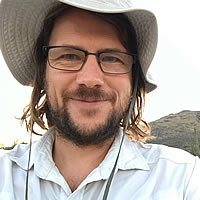
Josh Ness
Associate Professor @ Skidmore since 2005
Address:
Biology Department - CIS 230C
Skidmore College
Saratoga Springs, NY 12866
Telephone:
(518) 580-5080
Fax:
(518) 580-5071
Email:
jness@skidmore.edu
Focus of Research and Teaching:
Mutualism and parasitism, landscape change, biological invasions, plant-animal interactions, plant defense and dispersal, urban ecology, climatic drivers of variation in inter-specific interactions.
Courses:
Life In the North Woods (First Year seminar), Human Nature (First Year seminar), Organismal Biology, Conservation and Use of Terrestrial Landscapes, Plant-Animal Interactions, Biological Invasions, Parasites, Epidemics and Public Health: An Integrated Approach, Global Change Biology.
Publications * indicates undergraduate co-author
Brown ME, R Oviedo, JD Corbin, JH Ness, R Borroto-Páez, TS McCay, and M Farnsworth. (in press) Plant Pirates of the Caribbean: is Cuba sheltered by its revolutionary economy? Frontiers in Ecology and the Environment
Ness, JH (2020) Hot spots and hot moments for on-plant foraging within the flora of warm North American deserts. American Midland Naturalist 183: 145-163
Ness JH and DA Holway (2017) Mutualisms and the reciprocal benefits of comparing systems
with native and introduced ants. Chapter 14, in (Oliveira and Koptur, eds) Ant-Plant
Interactions: Impacts of Humans on Terrestrial Ecosystems (Cambridge University Press)
Ness JH, M Pfeffer*, L Combs*, E Nathan*, A Guest* and J Stark* (2016) In an arid urban matrix,
fragment size and isolation predict access to the frugivory and rainfall necessary
for plant population persistence. Ecosphere
Jones EI, ML Friesen, ME Afkhami, E Akcay, JL Bronstein, R Bshary, ME Frederickson, KD Heath, J Hoeksema, JH Ness, S Pankey, SS Porter, JL Sachs, and K Scharnagl (2015) Cheaters must prosper: reconciling theoretical and empirical perspectives on cheating in mutualism. Ecology Letters.
Ford, K.R., J.H. Ness, J.L. Bronstein and W.F. Morris (2015) Demographic consequences of mutualism: integrating multiple effects of ants on the population dynamics of a partner plant. Oecologia.
Ness, J.H., M.A. Morales, E. Kenison*, E. LeDuc*, P. Leipzig-Scott*, E. Rollinson*, B.J. Swimm* and D.R. VonAllmen* (2012). Reciprocally beneficial interactions between introduced plants and ants are induced by the presence of a third introduced species. Oikos (pdf)
Ness J.H., E.J. Rollinson* and K.D. Whitney. (2011) Phylogenetic distance can predict susceptibility to attack by natural enemies. Oikos (pdf)
Ness J.H., K. Mooney and L. Lach (2010) Ants as mutualists. Ch 6 in (Lach L, CL Parr and K Abbott, eds.) Ant Ecology. Oxford University Press, Oxford. (pdf)
Ness, J.H., W.F. Morris and J.L. Bronstein (2009) For ant-protected plants, the best defense is a hungry offense. Ecology 90: 2823-2831 (pdf)
Ness, J.H., D.F. Morin* and I. Giladi (2009) Uncommon specialization in a mutualism between a temperate herbaceous plant guild and an ant: Are Aphaenogaster ants keystone mutualists? Oikos 118: 1793-1804 (pdf)
Ness, J.H. and D. Morin* (2008) Forest edges and landscape history shape interactions between plants, seed-dispersing ants and seed predators. Biological Conservation 141: 838-847 (pdf)
Bronstein, J.L. and J.H. Ness (2007) 'Friends of Friends? Barrel cactus and its interacting mutualists'. The Arizona Native Plant Society's Plant Press 31: 8-10
Ness, J.H., W.F. Morris & J.L. Bronstein. (2006) Variation in mutualistic potential among ant species tending extrafloral nectaries of Ferocactus wislizeni . Ecology 87: 912-921 (pdf)
Ness, J.H. (2006) A mutualism's indirect costs: The most aggressive plant bodyguards also deter pollinators. Oikos 113: 506-514 (pdf)
Morris, W.F., W.G. Wilson, J.L. Bronstein & J.H. Ness. (2005) Environmental forcing and the temporal dynamics of a competitive guild of cactus-tending ants. Ecology 86: 3190-3199 (pdf)
Ness, J.H. & K. Bressmer* (2005) Abiotic influences on the behavior of rodents, ants, and plants affect an ant-seed mutualism. Ecoscience 12: 76-81 (pdf)
Holland, J.N., J.H. Ness, A. Boyle & J.L. Bronstein (2005) Mutualisms as consumer-resource interactions. Pp 17-33 In (P. Barbosa and I. Castellanos, eds.) Ecology of Predator - Prey Interactions . Oxford University Press, New York
Ness, J.H., J.L. Bronstein, A.N. Andersen & J.N. Holland (2004) Ant body size predicts dispersal distance of ant-adapted seeds: implications of small-ant invasions. Ecology 85: 1244-1250 (pdf)
Ness, J.H. (2004) Forest edges and fire ants alter the seed shadow of an ant-dispersed plant. Oecologia 138: 228-454 (pdf)
Ness, J.H. & J.L. Bronstein (2004) The effects of invasive ants on prospective ant mutualists. Biological Invasions 6: 445-461
Holland, J.N., R. Wyatt, J.L. Bronstein & J.H. Ness (2004) Relating the biology of flower-to-fruit survivorship to the ecology and evolution of fruit-to-flower ratios. Recent Research Developments in Plant Science 1: 75-84
Ness, J.H. (2003) Catalpa bignonioides alters extrafloral nectar production after herbivory and attracts ant bodyguards. Oecologia 134: 210-218 (pdf)
Ness, J.H. (2003) Contrasting exotic Solenopsis invicta and native Forelius pruinosus ants as mutualists with Catalpa bignonioides , a native plant. Ecological Entomology 28: 247-251 (pdf)
Ness, J.H. & S. A. Foster. (1999) Parasite mediated phenotype modifications in the threespine stickleback. Oikos 85: 127-134 (pdf)
Windsor, D., J. Ness , L.D. Gomez & P.H. Jolivet. (1999) Species of Aulacoscelis Duponchel and Chevrolat (Chrysomelidae) and Nomotus Gorham (Languriidae) feed on fronds of Central American cycads. The Coleopterist Bulletin 53: 217-231.